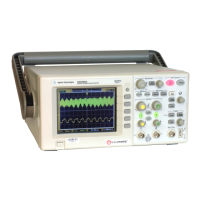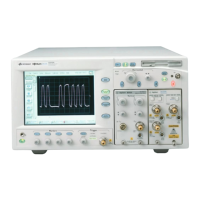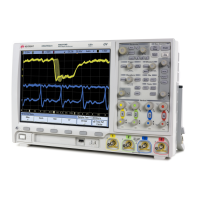:WAVeform Commands 32
Agilent InfiniiVision 3000 X-Series Oscilloscopes Programmer's Guide 963
Normal data consists of the last data point (hit) in each time bucket. This
data is transmitted over the programming interface in a linear fashion
starting with time bucket 0 and going through time bucket n - 1, where n
is the number returned by the :WAVeform:POINts? query (see page 972).
Only the magnitude values of each data point are transmitted. The first
voltage value corresponds to the first time bucket on the left side of the
screen and the last value corresponds to the next- to- last time bucket on
the right side of the screen. Time buckets without data return 0. The time
values for each data point correspond to the position of the data point in
the data array. These time values are not transmitted.
AVERage Data
AVERage data consists of the average of the first n hits in a time bucket,
where n is the value returned by the :ACQuire:COUNt query (see
page 230). Time buckets that have fewer than n hits return the average of
the data they do have. If a time bucket does not have any data in it, it
returns 0.
This data is transmitted over the interface linearly, starting with time
bucket 0 and proceeding through time bucket n-1, where n is the number
returned by the :WAVeform:POINts? query (see page 972). The first value
corresponds to a point at the left side of the screen and the last value
corresponds to one point away from the right side of the screen. The
maximum number of points that can be returned in average mode is 1000
unless ACQuire:COUNt has been set to 1.
PEAK Data
Peak detect display mode is used to detect glitches for time base settings
of 500 us/div and slower. In this mode, the oscilloscope can sample more
data than it can store and display. So, when peak detect is turned on, the
oscilloscope scans through the extra data, picks up the minimum and
maximum for each time bucket, then stores the data in an array. Each
time bucket contains two data sample.
The array is transmitted over the interface bus linearly, starting with time
bucket 0 proceeding through time bucket n- 1, where n is the number
returned by the :WAVeform:POINts? query (see page 972). In each time
bucket, two values are transmitted, first the minimum, followed by the
maximum. The first pair of values corresponds to the time bucket at the
leftmost side of the screen. The last pair of values corresponds to the time
bucket at the far right side of the screen. In :ACQuire:TYPE PEAK mode
(see page 239), the value returned by the :WAVeform:XINCrement query
(see page 989) should be doubled to find the time difference between the
min- max pairs.
HRESolution Data

